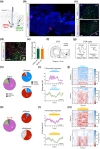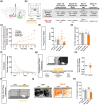Laterodorsal tegmentum-ventral tegmental area projections encode positive reinforcement signals
- PMID: 34374447
- PMCID: PMC9541203
- DOI: 10.1002/jnr.24931
Laterodorsal tegmentum-ventral tegmental area projections encode positive reinforcement signals
Abstract
The laterodorsal tegmentum (LDT) is a brainstem nucleus classically involved in REM sleep and attention, and that has recently been associated with reward-related behaviors, as it controls the activity of ventral tegmental area (VTA) dopaminergic neurons, modulating dopamine release in the nucleus accumbens. To further understand the role of LDT-VTA inputs in reinforcement, we optogenetically manipulated these inputs during different behavioral paradigms in male rats. We found that in a two-choice instrumental task, optical activation of LDT-VTA projections shifts and amplifies preference to the laser-paired reward in comparison to an otherwise equal reward; the opposite was observed with inhibition experiments. In a progressive ratio task, LDT-VTA activation boosts motivation, that is, enhances the willingness to work to get the reward associated with LDT-VTA stimulation; and the reverse occurs when inhibiting these inputs. Animals abolished preference if the reward was omitted, suggesting that LDT-VTA stimulation adds/decreases value to the stimulation-paired reward. In addition, we show that LDT-VTA optical activation induces robust preference in the conditioned and real-time place preference tests, while optical inhibition induces aversion. The behavioral findings are supported by electrophysiological recordings and c-fos immunofluorescence correlates in downstream target regions. In LDT-VTA ChR2 animals, we observed an increase in the recruitment of lateral VTA dopamine neurons and D1 neurons from nucleus accumbens core and shell; whereas in LDT-VTA NpHR animals, D2 neurons appear to be preferentially recruited. Collectively, these data show that the LDT-VTA inputs encode positive reinforcement signals and are important for different dimensions of reward-related behaviors.
Keywords: LDT; motivation; neuronal circuits; optogenetics; reward.
© 2021 The Authors. Journal of Neuroscience Research published by Wiley Periodicals LLC.
Conflict of interest statement
The authors declare no conflict of interest.
Figures




Similar articles
-
Role of laterodorsal tegmentum projections to nucleus accumbens in reward-related behaviors.Nat Commun. 2019 Sep 12;10(1):4138. doi: 10.1038/s41467-019-11557-3. Nat Commun. 2019. PMID: 31515512 Free PMC article.
-
Impairments in laterodorsal tegmentum to VTA projections underlie glucocorticoid-triggered reward deficits.Elife. 2017 Aug 24;6:e25843. doi: 10.7554/eLife.25843. Elife. 2017. PMID: 28837419 Free PMC article.
-
Activation of Pedunculopontine Glutamate Neurons Is Reinforcing.J Neurosci. 2017 Jan 4;37(1):38-46. doi: 10.1523/JNEUROSCI.3082-16.2016. J Neurosci. 2017. PMID: 28053028 Free PMC article.
-
Reward and aversion in a heterogeneous midbrain dopamine system.Neuropharmacology. 2014 Jan;76 Pt B(0 0):351-9. doi: 10.1016/j.neuropharm.2013.03.019. Epub 2013 Apr 8. Neuropharmacology. 2014. PMID: 23578393 Free PMC article. Review.
-
Neuroplasticity in cholinergic neurons of the laterodorsal tegmental nucleus contributes to the development of cocaine addiction.Eur J Neurosci. 2019 Aug;50(3):2239-2246. doi: 10.1111/ejn.13962. Epub 2018 Jul 21. Eur J Neurosci. 2019. PMID: 29791036 Review.
Cited by
-
Nicotine Withdrawal Drives Aversive Behaviors by Recruiting Inhibitory Interpeduncular Nucleus Inputs to the Laterodorsal Tegmentum in Mice.J Neurosci. 2025 Aug 6;45(32):e2405242025. doi: 10.1523/JNEUROSCI.2405-24.2025. J Neurosci. 2025. PMID: 40659528 Free PMC article.
-
Striatal dopamine signals are region specific and temporally stable across action-sequence habit formation.Curr Biol. 2022 Mar 14;32(5):1163-1174.e6. doi: 10.1016/j.cub.2021.12.027. Epub 2022 Feb 7. Curr Biol. 2022. PMID: 35134325 Free PMC article.
References
-
- Al‐Hasani, R. , McCall, J. G. , Shin, G. , Gomez, A. M. , Schmitz, G. P. , Bernardi, J. M. , Pyo, C.‐O. , Park, S. I. , Marcinkiewcz, C. M. , Crowley, N. A. , Krashes, M. J. , Lowell, B. B. , Kash, T. L. , Rogers, J. A. , & Bruchas, M. R. (2015). Distinct subpopulations of nucleus accumbens dynorphin neurons drive aversion and reward. Neuron, 87(5), 1063–1077. 10.1016/j.neuron.2015.08.019 - DOI - PMC - PubMed
-
- Aragona, B. J. , Cleaveland, N. A. , Stuber, G. D. , Day, J. J. , Carelli, R. M. , & Wightman, R. M. (2008). Preferential enhancement of dopamine transmission within the nucleus accumbens shell by cocaine is attributable to a direct increase in phasic dopamine release events. Journal of Neuroscience, 28(35), 8821–8831. 10.1523/JNEUROSCI.2225-08.2008 - DOI - PMC - PubMed
-
- Beier, K. T. , Steinberg, E. E. , DeLoach, K. E. , Xie, S. , Miyamichi, K. , Schwarz, L. , Gao, X. J. , Kremer, E. J. , Malenka, R. C. , & Luo, L. (2015). Circuit architecture of VTA dopamine neurons revealed by systematic input‐output mapping. Cell, 162(3), 622–634. 10.1016/j.cell.2015.07.015 - DOI - PMC - PubMed
Publication types
MeSH terms
LinkOut - more resources
Full Text Sources

